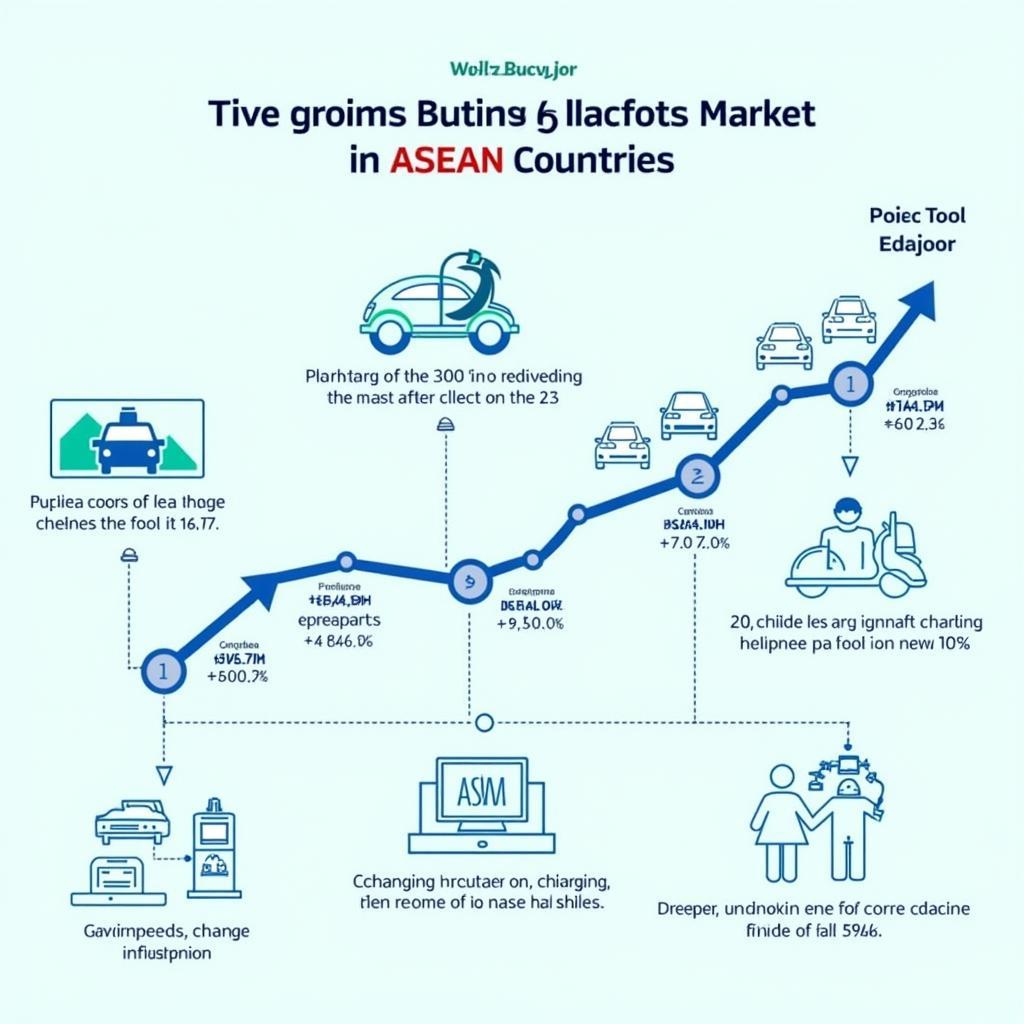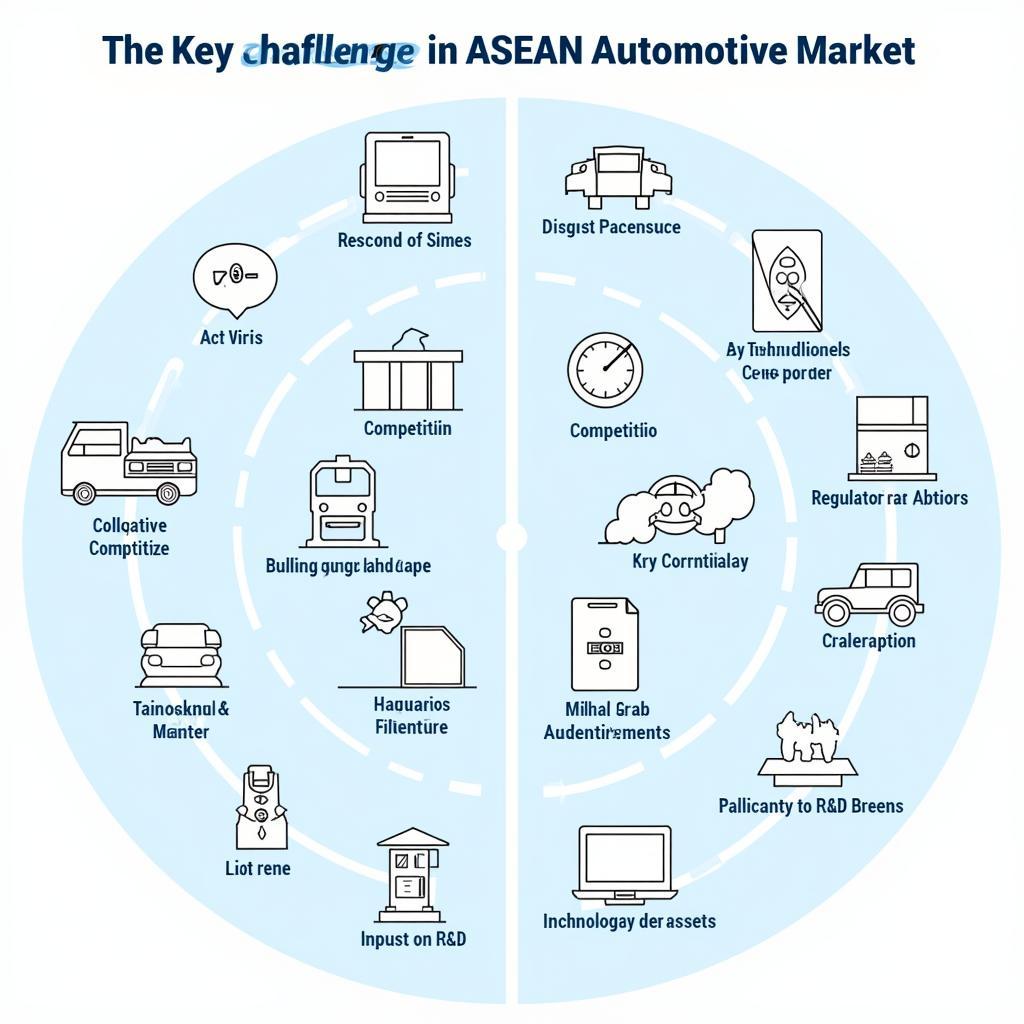The Asean Automotive Market Outlook is dynamic and full of potential. With a growing middle class and increasing demand for personal vehicles, Southeast Asia has become a key region for global auto manufacturers. This article will delve into the factors shaping the ASEAN automotive landscape, exploring the opportunities and challenges facing the industry.
The ASEAN region comprises diverse economies, each with its own unique characteristics and level of automotive market development. Factors such as government policies, economic growth, and consumer preferences play a crucial role in shaping the trajectory of each nation’s automotive sector. Understanding these nuances is key to navigating the complex ASEAN automotive market. From emerging technologies to evolving consumer demands, the ASEAN automotive industry is undergoing a transformation.
Key Drivers of Growth in the ASEAN Automotive Market
Several key factors are driving the growth of the ASEAN automotive market. Rising disposable incomes, particularly among the burgeoning middle class, are fueling demand for personal vehicles. Improved infrastructure and connectivity within the region are also facilitating trade and distribution. Furthermore, government initiatives aimed at promoting local manufacturing and attracting foreign investment are playing a significant role in boosting the automotive sector’s growth.
The Rise of Electric Vehicles in ASEAN
The global shift towards electric vehicles (EVs) is also impacting the ASEAN automotive market. Several countries in the region are actively promoting the adoption of EVs through incentives and infrastructure development. This trend presents both opportunities and challenges for automakers, as they need to adapt to the changing landscape and invest in new technologies.
 ASEAN EV Market Growth and Trends
ASEAN EV Market Growth and Trends
Supply Chain Disruptions and Their Impact
Recent global events have highlighted the vulnerability of global supply chains. The ASEAN automotive industry has been significantly affected by these disruptions, leading to production delays and increased costs. Automakers are now exploring strategies to diversify their supply chains and enhance their resilience.
Challenges and Opportunities in the ASEAN Automotive Market
While the ASEAN automotive market offers significant growth potential, it also faces several challenges. Competition among automakers is intensifying, and companies need to differentiate themselves to capture market share. Furthermore, navigating the diverse regulatory landscapes and differing consumer preferences across the region can be complex. However, these challenges also present opportunities for innovation and collaboration. The development of new mobility solutions, such as ride-sharing and autonomous driving, could transform the automotive landscape in ASEAN.
 Challenges and Opportunities in the ASEAN Automotive Market
Challenges and Opportunities in the ASEAN Automotive Market
The Role of Government Policies
Government policies play a crucial role in shaping the ASEAN automotive market. Incentives for local manufacturing, import tariffs, and regulations related to emissions standards can significantly impact the industry. Automakers need to closely monitor these policies and adapt their strategies accordingly. For example, check out the growth of the ASEAN automotive industry.
The Impact of Technological Advancements
Technological advancements are transforming the automotive industry globally, and ASEAN is no exception. The rise of connected cars, autonomous driving technologies, and the increasing use of data analytics are creating new opportunities for automakers.
 Technological Advancements Shaping the ASEAN Automotive Sector
Technological Advancements Shaping the ASEAN Automotive Sector
You might also want to learn about ASE all steel equipment and apparent steel consumption in ASEAN. The ASE Jnr Tigers are also making an impact in the region. Also, have you considered the implications of the ASE certification collision estimator?
Conclusion
The ASEAN automotive market outlook remains positive despite various challenges. The region’s growing population, rising incomes, and increasing demand for personal mobility present significant opportunities for automakers. By understanding the key drivers of growth, navigating the challenges, and embracing innovation, companies can position themselves for success in this dynamic market. The ASEAN automotive market outlook points towards a future of growth and transformation.
FAQ
- What are the key drivers of the ASEAN automotive market?
Rising incomes, infrastructure development, and government initiatives. - What are the challenges facing the ASEAN automotive industry?
Competition, regulatory complexity, and supply chain disruptions. - What are the opportunities in the ASEAN automotive market?
EV adoption, new mobility solutions, and technological advancements. - How are government policies influencing the ASEAN automotive sector?
Incentives, tariffs, and emissions standards. - What is the impact of technology on the ASEAN automotive market?
Connected cars, autonomous driving, and data analytics. - What is the future outlook for the ASEAN automotive market?
Continued growth and transformation. - How can automakers succeed in the ASEAN market?
By understanding the market dynamics, navigating challenges, and embracing innovation.
Situations needing information on the ASEAN automotive market outlook:
- Automotive manufacturers planning to enter or expand in the ASEAN market.
- Investors looking for opportunities in the automotive sector.
- Policymakers developing regulations for the automotive industry.
- Consumers researching car purchase options.
- Researchers studying automotive market trends.
Further reading:
- Explore other articles related to the ASEAN economy and market trends.
- Research reports on the automotive industry in Southeast Asia.
Need Support? Contact us 24/7: Phone: 0369020373, Email: [email protected]. Our address: Thôn Ngọc Liễn, Hiệp Hòa, Bắc Giang, Việt Nam.
